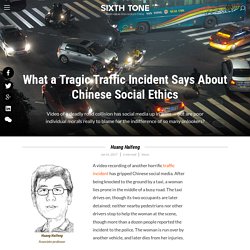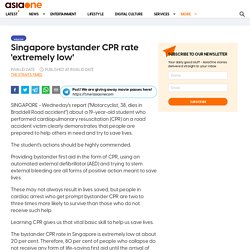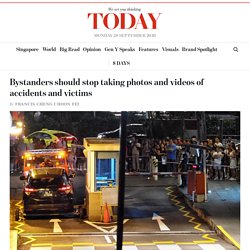

From apathy to empathy. In a nutshell. Bystander Intervention in Emergencies: Diffusion of Responsibility. Summary: Bystander Intervention in Emergencies: Diffusion of Responsibility. Are We Victims Of "Bystander Effect"? The Science of Empathy. Comments: The Bystander Effect. A trip down memory lane. Infamous Murderer of Kitty Genovese Dies in Prison at 81. Summary: Infamous Murderer of Kitty Genovese Dies in Prison at 81. How The Murder Of Kitty Genovese Created The Bystander Effect. Wikimedia CommonsKitty Genovese whose muder would inspire the psychological phenomenon known as the bystander effect.

At approximately 3:15 a.m. on March 13, 1964, a woman was murdered. Her name was Kitty Genovese. She was 28 years old, “self-assured beyond her years,” and had a “sunny disposition.” However, on that Friday evening, none of that mattered. As Kitty Genovese was stabbed to death in an alleyway outside her home, the friends and neighbors she had lived next to for several years stood by, choosing not to get involved as she lay there dying. Around 2:30 a.m. on the night of her attack, Kitty Genovese left the bar she worked at and headed for home. A few minutes after she left, she stopped at a traffic light. At 3:15, Genovese pulled into the parking lot of the Kew Gardens Long Island Rail Road station parking lot, which was about 100 feet from her front door. Learning points from 1964. Hindsight is 20/20. Just a picture to put things into perspective - it aptly illustrates the undercurrents of our society. What the Kitty Genovese Killing Can Teach Today’s Digital Bystanders.
As Retro Report notes, two social psychologists in New York, John M. Darley and Bibb Latané, conducted experiments that led them to posit that Ms. Genovese might have survived had there been fewer witnesses. Numbers can inhibit action, they concluded. “You think that if there are many people who are witness to something that other people certainly already have done something — why should it be me?” Dr. A 2015 article in The Wisconsin Law Review cited studies showing that most instances of school bullying are witnessed by other students and that in nearly one-third of reported sexual assaults, third parties are present.
Summary: What the Kitty Genovese killing can teach today’s digital bystanders. Toddler incident in China shows 'volunteer's dilemma' - CNN. A security camera video of a toddler being run over twice on a street in China has swept across the Web in recent days and has drawn a chorus of horrified denunciations.

How, we wonder, could so many passers-by have so callously ignored the girl's plight? As humans, we are horrified when we learn that a person in distress is not helped, even when, as in this case, many potential helpers are present. Our horror increases if the person is victimized in a particularly vicious or careless way by fellow human beings. Our horror is further heightened when we learn that the victim is helpless and the kind of person who normally stimulates our instinct to aid and protect.
Our spontaneous reaction is to say: "Had I been there, I would have helped; what is wrong with these people? " It is true that cultural differences exist in many aspects of human behavior, and many of these differences are not trivial. Since the original experiments, many studies have explored the bystander effect. Comments: Toddler incident in China shows ‘volunteers’ dilemma’ Are we just... inherently selfish? Why we still look away: Kitty Genovese, James Bulger and the bystander effect.
More than half a century later, the death of Kitty Genovese continues to remind us of the disconnect between what we believe about ourselves and how we really act under pressure.

The murder of the 28-year-old outside her apartment in the Queens neighborhood of Kew Gardens in the early morning of 13 March 1964 rippled through New York City and around the world. How could a young, independent woman who lived on her own terms be so easily struck down? How could so many neighbors look on and turn away as she was stabbed repeatedly on the street and in her apartment building? What did that collective inability to act reveal about ourselves, our communities, and our belief systems? Genovese’s killer, Winston Moseley, died in prison this week, bringing the case and its implications back into the spotlight. Two weeks after her murder, Rosenthal assigned a story with the damning headline: “Thirty-Seven Who Saw Murder Didn’t Call Police.”
Summary: Why we still look away: Kitty Genovese, James Bulger and the bystander effect. What a Tragic Traffic Incident Says About Chinese Social Ethics. A video recording of another horrific traffic incident has gripped Chinese social media.

After being knocked to the ground by a taxi, a woman lies prone in the middle of a busy road. The taxi drives on, though its two occupants are later detained; neither nearby pedestrians nor other drivers stop to help the woman at the scene, though more than a dozen people reported the incident to the police. The woman is run over by another vehicle, and later dies from her injuries. The incident actually happened in April 2017 in Zhumadian, a city in central China’s Henan province, but the surveillance video surfaced only last week. Like similar previous scandals, web users blamed Chinese people’s supposed apathy, lack of proper ethical values, or the seemingly perennial problem of having low suzhi — a Chinese term roughly equivalent to civic awareness that is commonly cited as an impediment to embodying a civilized society.
China’s bystander problem: Another death after crowd ignores woman in peril - The Washington Post (click to open the entire article) Summary of articles: “What a tragic traffic incident says about Chinese social ethics” and “China’s bystander problem: Another death after crowd ignores woman in peril” Bystander "Apathy" Summary: Bystander "Apathy" Commentary: Reasons we look the other way. To "kaypoh" or not to "kaypoh"? That is the question. How to be kinder to strangers in Singapore, Opinion News. The Charities Aid Foundation recently released the World Giving Index 2017, which provides insight into the scope and nature of giving around the world. Based on data collected from the Gallup World Poll, the index, which polled 1,000 individuals in each representative country, revealed two surprising facts.
Myanmar, Indonesia and Kenya turned out to be among the most charitable countries, even though they have a huge number of their populations living below the poverty line. Being poor does not stop one from being generous. Wealthy countries such as the United States, Canada, New Zealand, Australia and the United Arab Emirates also feature in the top 10. Myanmar, the top country for four years in a row, has a poor human rights record, in part because of its treatment of the Rohingya Muslims. Singapore, ranked 30, is behind Indonesia (2), Myanmar (1) and Thailand (15), but streets ahead of Cambodia (134), Vietnam (116) and the Philippines (54) in Asean. Commentary: How to be kinder to strangers in Singapore. Singapore bystander CPR rate 'extremely low', Health News. SINGAPORE - Wedneday's report ("Motorcyclist, 38, dies in Braddell Road accident") about a 19-year-old student who performed cardiopulmonary resuscitation (CPR) on a road accident victim clearly demonstrates that people are prepared to help others in need and try to save lives.

The student's actions should be highly commended. Providing bystander first aid in the form of CPR, using an automated external defibrillator (AED) and trying to stem external bleeding are all forms of positive action meant to save lives. These may not always result in lives saved, but people in cardiac arrest who get prompt bystander CPR are two to three times more likely to survive than those who do not receive such help. Learning CPR gives us that vital basic skill to help us save lives. The bystander CPR rate in Singapore is extremely low at about 20 per cent. Commentary: Singapore bystander CPR rate ‘extremely low’
TODAYonline. I refer to the news reports of the fatal traffic accident on Sunday (Dec 29) at Lucky Plaza.

I applaud the Good Samaritans who unselfishly helped to lift up the car, pulled the victims out and attended to them. These are acts of true heroism. They encourage us to lend help to accident victims when needed and show that there are still compassionate people who don’t respond to accidents by whipping out their phones first to take videos and photos to circulate to their friends. In Sunday’s incident, one of the first things a bystander could do was to rush to the nearby Mount Elizabeth Hospital Accident and Emergency Department to seek help, as it would have the necessary medical equipment and trauma specialists on duty.
This was crucial as the Singapore Civil Defence Force ambulances would take some time to arrive and the accident victims needed immediate medical attention and first aid. Commentary: Bystanders should stop taking photos and videos of accidents and victims. Written Answer by Minister for Law, K Shanmugam, to Parliamentary Question on the introduction of a Good Samaritan law in Singapore. 14 Feb 2012 Posted in Parliamentary speeches and responses Associate Professor Fatimah Lateef, Marine Parade GRC Question To ask the Minister for Law whether it is time to reconsider the appropriateness of introducing a Good Samaritan law in Singapore.

Answer The honourable Member last raised this issue in 2008 with Professor S Jayakumar, then the Deputy Prime Minister and Minister for Law. TODAYonline. SINGAPORE — There is no need for a Good Samaritan Law, because Singaporeans continue to render assistance when needed, said Senior Minister of State for Law and Education Indranee Rajah.

Speaking in Parliament today (May 29), Ms Indranee said the issue had been brought before the House twice before. The reasons deeming the law unnecessary then, still hold today. A Good Samaritan Law protects people who render help during emergencies from criminal or civil liability. Ms Indranee explained that current laws do not give rise to any major liability concerns for Good Samaritans. In terms of civil liability, people who render assistance must only comply with a standard of care that can be “reasonably expected of a person of his skill and experience”. Commentary: Good Samaritan Law in Singapore. Be an "aunty", don't just employ "eye power" The Bystander Effect - You Can Break the Cycle. The 5 Step Bystander Process.
Key Takeaway from: You can break the cycle. Bystander Effect: What Is It and What You Can Do About It. What the bystander effect looks like A little after 3 a.m. on March 13, 1964, Catherine “Kitty” Genovese parked her car and walked to her apartment in Queens, New York, after finishing her shift as a bar manager. Serial killer Winston Moseley was out to victimize someone that night. Genovese became his target. When he followed her, she ran. As Moseley reached her and began stabbing her with a hunting knife, Genovese screamed, “Oh, my God, he stabbed me! Summary: Bystander Effect: What Is It and What You Can Do About It. Overcoming the Bystander Effect. Learning Points: Overcoming the Bystander Effect – The Psychology of Heroism. The Bystander Effect - Standing Up From the Crowd - Extra Credits. Learning Points: The Bystander Effect – Standing Up From the Crowd.
How tech can combat the bystander effect. The responsibility to help during an emergency falls on anyone present and capable of lending a hand.

Salient Points: How tech can combat the bystander effect. The bystander effect is complicated. Key Points: The Bystander Effect is Complicated – here’s why. Conclusion.